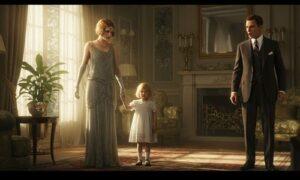In F. Scott Fitzgerald’s The Great Gatsby, the most revealing truths are often found not in grand declarations but in subtle, overlooked details. One character who embodies this principle remarkably well is Pammy Buchanan, Tom and Daisy’s toddler daughter.
She appears physically in only a single, brief scene. But she’s less a character and more a potent symbol whose fleeting presence, and more significantly, her sustained absence, is a devastating commentary on her parents’ moral world and the very nature of Gatsby’s dream.
Our analysis of Pammy Buchanan argues that her significance lies not in her actions but as a symbol and a strategic narrative omission. We contend that Pammy is the novel’s most powerful and inconvenient truth: the living embodiment of an unrepeatable past.
Her brief appearance shatters Gatsby’s illusion, while her conspicuous absence from the story’s climactic moments reveals her parents’ selfishness and moral bankruptcy. By deconstructing her role, we illuminate the hollow core of the American Dream as Fitzgerald presents it.
For essential plot context, please read our summary of The Great Gatsby.
Note: This analysis delves into Pammy Buchanan’s symbolic role in The Great Gatsby and will necessarily discuss plot developments and critical interpretations of the novel’s central themes. Reader discretion is advised if you have not yet completed the book.

A Product of Neglect: The “Beautiful Little Fool” and Her Absent Parents
Long before Pammy appears on the page, she exists as an idea born from parental neglect and disillusionment. Her mother’s hopes for her future and the narrator’s detached reaction to her existence provide a chilling framework for understanding the emotionally barren world into which the child has been born.
A Mother’s Cynical Wish, A Father’s Absence
Our introduction to Pammy’s potential fate comes through Daisy’s disillusionment, a feeling explicitly linked to Tom’s neglect from the moment of their child’s birth.
Recounting the experience to Nick, Daisy says, “…she was less than an hour old and Tom was God knows where. I woke up out of the ether with an utterly abandoned feeling…” [Chapter 1, Page 17]. It’s from this moment of abandonment that her cynical wish for her daughter is born: “‘All right,’ I said, ‘I’m glad it’s a girl. And I hope she’ll be a fool—that’s the best thing a girl can be in this world, a beautiful little fool’” [Chapter 1, Page 17].
This startling statement is not just a general critique of society; it’s a direct response to her own experience within her marriage. It reveals her belief that for a woman, blissful ignorance is preferable to the painful awareness of her husband’s indifference.
Fitzgerald depicts Pammy as shaped by her father’s absence and her mother’s cynicism from the moment she’s born.
The Objectified Child: A Mother’s Prize, A Narrator’s Abstraction
The perception of Pammy as more of a concept than a person is reinforced by the way Daisy and even Nick speak of her.
When Daisy first mentions her toddler daughter to Nick, his response is awkward and objectifying: “‘I suppose she talks, and—eats, and everything.’” [Chapter 1, Page 17]. His phrasing reduces the child to a set of basic biological functions, much like one would describe a pet. This reveals how the emotional detachment of the Buchanans can infect the perceptions of those around them, making it challenging to see Pammy as a fully realized human being.
Daisy reinforces this objectification by how she physically presents Pammy to Gatsby in Chapter 7. The interaction is not one of genuine maternal affection, but of social performance.
Daisy “shows off” her daughter as one might a prized possession, turning her towards Gatsby and asking, “‘Do you think they’re pretty?’” [Chapter 7, Page 117]. The child, in her moment of simple desire, asks, “‘Where’s Daddy?’” Instead of answering or acknowledging her daughter’s question, Daisy immediately deflects, reasserting her ownership and turning the focus back to appearances: “‘She doesn’t look like her father,’ explained Daisy. ‘She looks like me. She’s got my hair and shape of the face.’” [Chapter 7, Page 117].
This exchange masterfully reveals Daisy’s character. She ignores her child’s emotional bid for her father and instead uses her as a mirror, a beautiful object that validates her own physical attributes. This consistent portrayal of Pammy as a prop in her mother’s life solidifies her symbolic function as a beautiful, neglected accessory.
The Tangible Past: Pammy’s Confrontation with Gatsby’s Dream
For five years, Jay Gatsby constructs a dream based on the idea of erasing time and reclaiming a perfect moment with Daisy. In Chapter 7, that dream collides with a three-year-old reality he can’t ignore. In this section, we analyze Pammy’s single, pivotal appearance and its devastating effect on Gatsby’s illusion.
Pammy’s brief physical appearance during a tense afternoon at the Buchanan home is a masterstroke of narrative efficiency.
Daisy brings her daughter into the room almost as a novelty to be displayed for her guests. Her affection is performative and possessive: “‘Bles-sed pre-cious,’ she crooned… ‘Come to your own mother that loves you’” [Chapter 7, Page 117]. She presents Pammy to Gatsby, asking, “‘Do you think they’re pretty?’” The child, in her simple white dress, is treated as another beautiful object in Daisy’s collection.
But her presence shocks Gatsby. Nick observes that Gatsby “kept looking at the child with surprise. I don’t think he had ever really believed in its existence before” [Chapter 7, Page 117].
At that moment, Pammy becomes the living, breathing proof that Gatsby’s fundamental belief about the past can be repeated is false. She’s the undeniable evidence of the five years he has lost, the tangible proof of Daisy’s life with Tom.
While Gatsby can build a mansion, amass a fortune, and orchestrate a reunion, he cannot erase the existence of this child. Her presence shatters the hermetically sealed illusion of his dream, introducing a piece of reality so inconvenient that his mind had refused to process it.
After this brief, unsettling encounter, Pammy is whisked away by her nurse, her narrative function as a reality check complete.
The Unspoken Truth: Analyzing Pammy’s Crucial Absence from the Climax
Perhaps more significant than Pammy’s brief appearance is her unexplained absence from the novel’s most critical emotional moments. In this section, we analyze how Fitzgerald’s deliberate omission of Pammy from the Plaza Hotel confrontation reveals the true, self-absorbed nature of her parents’ conflict.
When the simmering tensions between Tom, Daisy, and Gatsby finally explode in the sweltering suite at the Plaza Hotel, the stakes are supposedly the future of Daisy’s life and love. Yet, in this vortex of passion, accusation, and shattered dreams, their daughter, Pammy, is never mentioned.
As Tom and Gatsby battle for possession of Daisy, their arguments center on the past (“‘I did love him once—but I loved you too’”) and the future (“‘Daisy’s leaving you’”), but never on the child who’s the most concrete bond between them and the most significant factor for any real future.
Fitzgerald’s narrative omission is a deliberate and damning choice. It reveals that the conflict isn’t about family or parental responsibility, but about ego, ownership, and romantic obsession. Neither Tom nor Daisy, in the heat of their emotional crisis, gives a single thought to their daughter’s welfare or how the outcome of their battle will affect her.
Pammy’s absence from their dialogue exposes their self-absorption. She’s a forgotten detail, an inconvenient reality left behind at the house while they engage in their destructive adult games. This makes their subsequent actions even more reprehensible; they’re not just careless lovers, but careless parents.
A Trophy in the Nursery: A Study in Parental Carelessness
Pammy Buchanan’s role as a symbol extends beyond just the past; she represents the ultimate product of her parents’ “vast carelessness,” treated more as a possession than a person. This is highlighted by Tom’s complete lack of paternal involvement and his misplaced grief over an aspect of his affair.
The Invisible Father: Tom’s Paternal Absence
Tom Buchanan’s role as a father is defined by consistent emotional and physical absence.
This is established long before the novel’s present action, when Daisy recounts that at the moment of Pammy’s birth, “Tom was God knows where” [Chapter 1, Page 17], leaving her feeling “utterly abandoned.” This initial neglect sets the stage for his behavior throughout the novel.
During Pammy’s single, brief appearance in Chapter 7, Tom isn’t even in the room for the primary interaction. He returns just as the nurse is leading the child away, and the text offers no indication that he speaks to, touches, or even acknowledges his daughter. His focus remains entirely on the adult drama with Gatsby.
This physical and interactive absence during his daughter’s only scene is a powerful indictment. It shows that for Tom, Pammy is not a person to be engaged with but a distant part of the domestic scenery he possesses.
The Puppy and the Child: A Devastating Contrast in Grief
The most chilling commentary on this parental detachment comes from an unlikely source: a box of dog biscuits.
After Myrtle’s death, Tom tells Nick he suffered too: “‘when I went to give up that flat and saw that damn box of dog biscuits sitting there I sat down and cried like a baby’” [Chapter 9, Page 178]. The narrative grants Tom a moment of grief over the accessory for his mistress, the puppy he bought on a whim, but never affords him a similar moment of paternal reflection about Pammy.
This contrast is devastating. The dog, a symbol of his illicit, exciting life with Myrtle, evokes a stronger emotional response from him than his own child does during the novel’s crises. Pammy, the “beautiful little fool,” is relegated to the status of a trophy in the nursery. She’s a symbol of a respectable family life to be maintained, but not a source of genuine emotional engagement or moral responsibility.
Pammy is the ultimate, quiet victim of her parents’ carelessness. She’ll inherit their wealth but not their attention.
The Child Who Shattered a Dream
Pammy Buchanan, in her brief, almost spectral appearance, is one of F. Scott Fitzgerald’s most efficient and devastating symbols. She’s the beautiful, inconvenient truth in a novel built on beautiful lies.
Her existence is the physical embodiment of the unrepeatable past, a living, breathing refutation of Jay Gatsby’s central, tragic belief that he can rewind time and “fix everything just the way it was before.”
More than just a reality check for Gatsby, Pammy is a silent, damning indictment of her parents. Her strategic absence from the novel’s emotional climax reveals the profound narcissism of Tom and Daisy, whose battle for possession and ego completely eclipses any sense of parental duty. She’s the ultimate symbol of the “things and creatures” they smash up in their wake.
Fitzgerald suggests through Pammy that the greatest casualty of the elite’s careless and self-absorbed world is not only love or dreams but also the future itself, represented by a child raised to be a beautiful fool in a morally bankrupt world.
To understand the woman who wished this upon her daughter, see our complete character analysis of Daisy Buchanan.
A Note on Page Numbers & Edition:
We carefully sourced textual references for this analysis from The Great Gatsby: The Only Authorized Edition (Scribner, November 17, 2020), ISBN-13: 978-1982149482. Just as Pammy Buchanan’s brief appearance offers a fleeting glimpse of reality, page numbers for specific events can differ across various printings. Always double-check against your copy to ensure accuracy for essays or citations.
